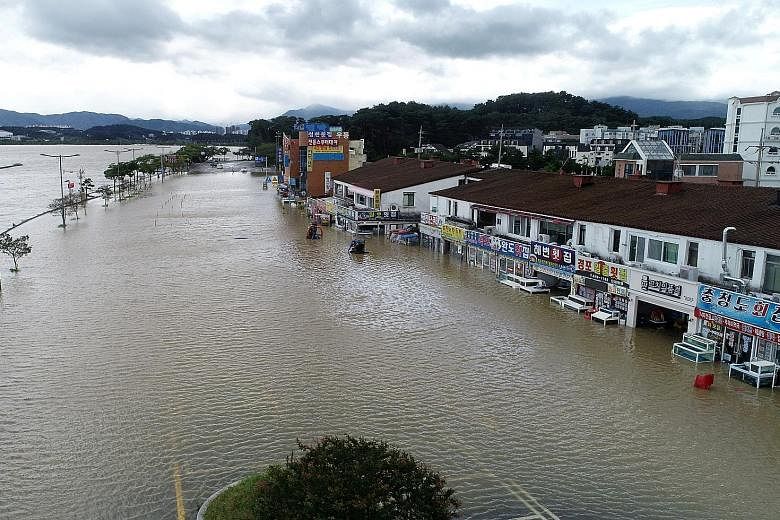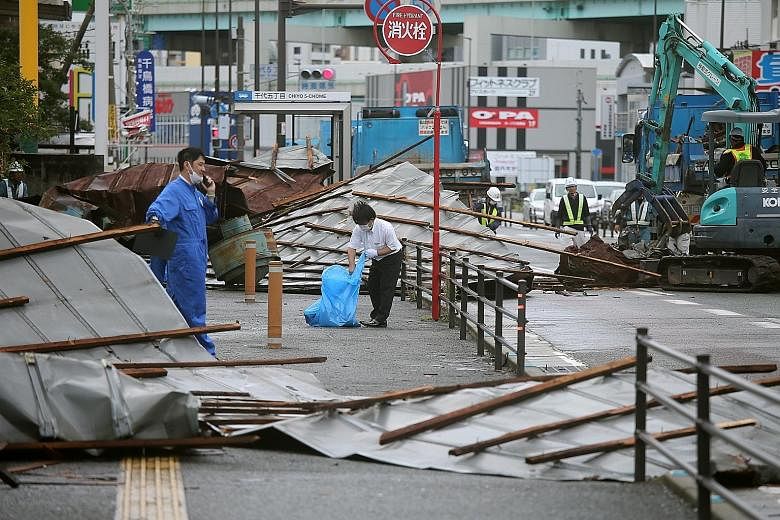A typhoon tore through the eastern coast of the Korean peninsula yesterday after leaving neighbouring Japan, where it had left at least 108 people injured and forced millions to evacuate to safer areas.
Packing winds of 150kmh, Typhoon Haishen made landfall in the southern Korean port city of Ulsan in the morning, bringing up to 70mm of rainfall per hour.
It left a trail of destruction, including at least 46 damaged structures, power outages in about 70,000 households in North and South Gyeongsang provinces, and numerous road closures due to flooding.
Local reports said about 1,640 people had to be evacuated and at least five people were injured.
One man in his 60s was struck on the head by a flyaway signboard, while a woman in her 50s fell due to strong winds and hurt her head. Both were sent to hospital.
Nearly 300 flights were grounded nationwide, said Korea Airports Corp.
Electricity was also knocked out in the Ulsan factories of South Korea's largest carmaker Hyundai.
Haishen, the 10th typhoon of the season, was expected to sweep upwards towards North Korea last night and then dissipate.
Chairing an emergency meeting yesterday, South Korean President Moon Jae-in ordered the government to carry out recovery work swiftly. He expressed concern over the extent of damage in some areas, which were already battered by Typhoon Maysak just days ago. He also told officials to remain alert.
In North Korea, state media reported that streets were already flooded and telephone cables cut yesterday before Haishen hit.
A typhoon warning was issued as up to 400mm of rain was expected in some regions, and residents living near the eastern shore in Tongchon county were evacuated.
Meanwhile, Japan has been picking up the pieces after Haishen brought the south-western island of Kyushu to a standstill, with as many as 8.8 million people urged to seek safety.
One person was confirmed dead as of last night, and at least 108 injured. Another four are missing, including two Vietnamese interns at a construction site after their office and neighbouring residence were washed away in a landslide in Shiiba village, in Miyazaki.
The storm engulfed almost all of Kyushu, about 50 times the size of Singapore, and packed winds as strong as 216kmh.
It forced the cancellation of nearly 600 domestic flights, and grounded train services across south-western Japan.
In a rare move, the Japan Meteorological Agency issued warnings more than three days in advance, saying, among other things, that the storm had the potential to "turn flying umbrellas into lethal weapons".
Hotels were booked out across Kyushu as people sought safety, with entry limits at evacuation centres to ensure social distancing amid the Covid-19 pandemic.
"I had to hurry because I was told that this evacuation centre would accept only 10 more people," Ms Kazuko Hamada, 67, told Kyodo News at a shelter near Kumamoto Station. She had gone to another evacuation facility initially but was turned away.
About 200,000 homes were still without power as at last night.
While unprecedented waves destroyed roads in coastal Kagoshima and record winds ripped the roof of a carpark in Nagasaki's Sasebo city, early assessments showed that the damage was much less than feared.
Singaporean Vanessa Cheong, 33, who lives in Nagasaki City, told The Straits Times that she prepared for the typhoon by taping her windows, filling her bathtub with water, and stocking up with a few days' worth of groceries.
"I was very worried that my windows would break. It was very loud and my doors were rattling," she said, adding that she was relieved that her home, as well as much of her city, emerged from the typhoon unscathed.


